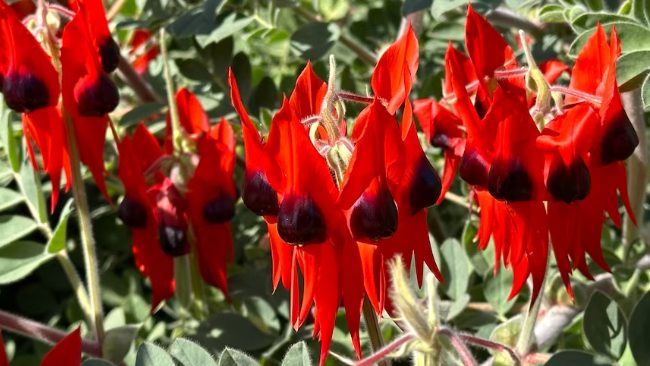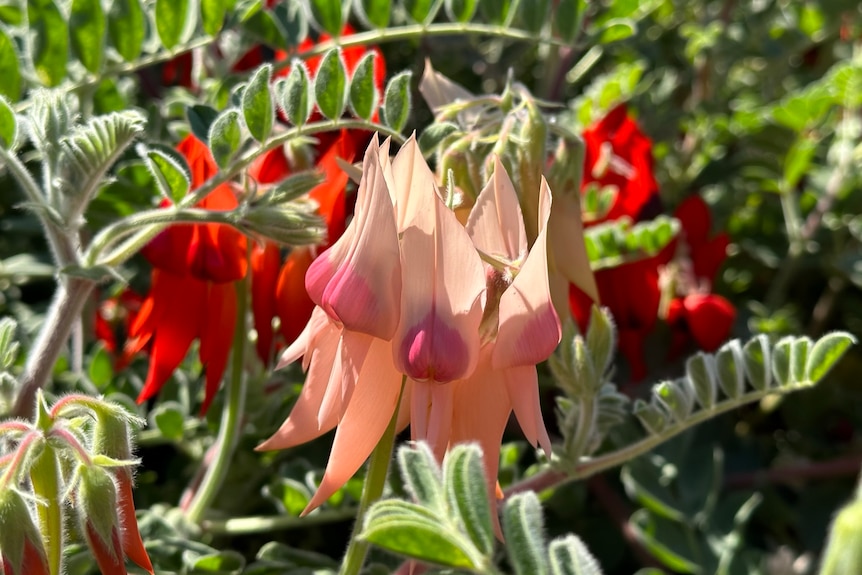
Sturt’s desert peas are popping up around Alice Springs after rainfall at the right time.(ABC Alice Springs: Emma Haskin)
Sturt’s desert pea numbers have exploded around Alice Springs, painting roundabouts, traffic islands and verges in a sea of red, black and green.
Alice Springs horticulturist Geoff Miers, who maintains an outcrop on a roundabout on the east side of town, said the conditions were ideal in the lead-up to the “magnificent” display.
He said that rain in April and again in June came at the perfect time.
“The peas germinated on both of those occasions,” he said.
Mr Miers said the roundabout was predominantly self-sown.
“It all looks after itself,” he said.
“I did have an incident last year where the peas grew magnificently and somebody decided to come and harvest every seed pod, which was really naughty.
“Once I cleaned up the roundabout, I did actually sow more seeds that I collected.”
 Geoff Miers tends to a spectacular Sturt’s desert pea display in Alice Springs.(ABC Alice Springs: Emma Haskin)
Geoff Miers tends to a spectacular Sturt’s desert pea display in Alice Springs.(ABC Alice Springs: Emma Haskin)
Mr Miers said soil conditions where the peas were growing also suited the native flower.
“You’ve got your good red soil underneath that’s been imported and then on top, you’ve got mulching material, whether it’s sand or laterite, or gravel,” he said.
“The seed will sit in the sand or the gravel or the rocks.
“It’ll sit there until such time as the rains come and come at the right time.”
He said the amount of seeds in the bank increased as more plants grew.
“And then you will find the odd plant popping up in the crack of a footpath or on the edge along a gutter or wherever,” he said.

Different varieties of the Sturt’s desert pea are also appearing.(ABC Alice Springs: Emma Haskin)
He said there were colour varieties of the same species popping up.
“You’ll get deep red with black centres, you get deep red or light red with red centres, you’ll get white ones, pink ones and even slightly greenish ones,” he said.
“Occasionally, you get even black ones, but I haven’t seen them.”
Cultivating rare blooms
Mr Miers said the peas were notoriously difficult to grow.
“They’re very susceptible to disease,” he said.
“The fungal disease Phytophthora, for example, basically it’s a disease that attacks the roots of the plant eats off the outer casing and so it can’t take up the nutrients it needs,” he said.
“So it shrivels up and dies.”
Mr Miers said the secret was to recreate the soil conditions that the flower naturally grew in and to prepare the seeds carefully by soaking them in boiling water until they swell up.
He said it could take as little as an hour or overnight.
“It’ll be four times the size of what it was before you put it in the hot water,” he said.
“You take that seed out and then you get into a seed-raising mix which is very light.”
Mr Miers said he preferred to use a mix of sand, perlite and some finely-sieved potting mix.
“I plant a seed into that and then I just work to keep it moist and the seed will pop up in within a week,” he said.
“Sometimes it takes longer.
“But once it pops up and it’s a few centimetres high, very carefully remove it from [the trays] and put it into pots.”





